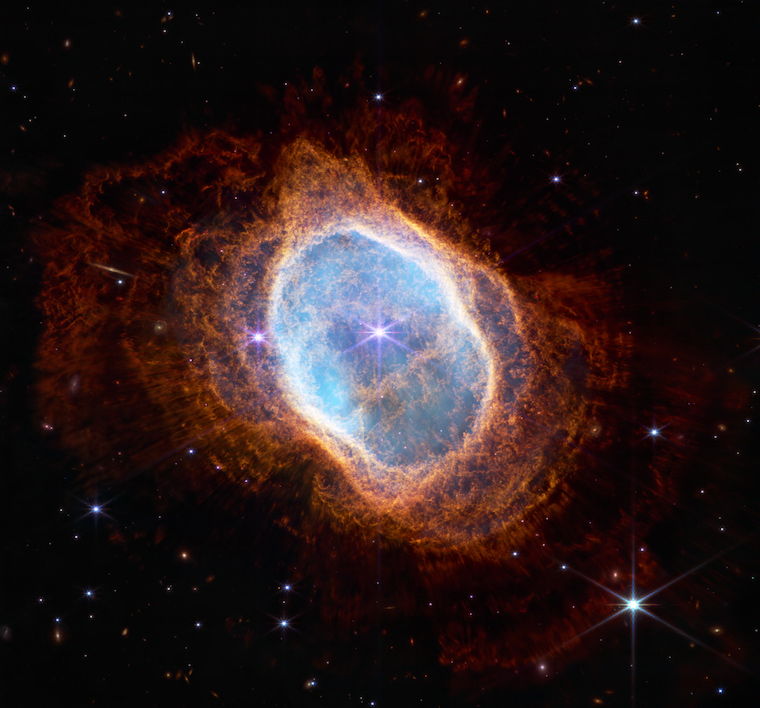Southern Ring Nebula

With the release of James Webb Space Telescope’s first images, now’s a good time as any to talk about planetary nebulas. The name itself is a misnomer - through early telescopes these looked like planets which did not move like actual planets did. Regardless, planetary nebulas are lit-up, ionised, expelled outer shell of a dying star. When a star with mass ranging from 0.8M☉ to 8M☉1 starts running out of hydrogen in its core, the delicate balance between its inwards gravitational pull and radially-outward radiation pressure is disturbed. The core starts contracting due to the reduced radiation pressure leading to higher temperatures and pressure in the core, while the cooler outer layers expand to form a red-giant star, dramatically increasing its luminosity. It is precisely at this point the star changes classification from a main-sequence star to its asymptotic giant branch (AGB) phase. Due to weaker gravitational pull, the star also starts venting a lot of its atmosphere into the interstellar medium. When the temperature of the exposed outer surface of the rapidly shrinking core reaches 30,000 K, it emits enough ultraviolet light to ionise the ejected shells of vented atmosphere, causing it to glow in different wavelengths.
This is a relatively short-lived phase in the stellar evolution, typically lasting around 10,000 years.2 At first, the core will maintain constant luminosity and energy output, while getting hotter and hotter and fusing helium into carbon and oxygen through the triple-alpha process. The temperature during this time reach up to 100,000K. When the core runs out of helium to fuse, it will shed its outer layers into the planetary nebula, leaving behind the carbon and oxygen rich core, called a white dwarf. White dwarfs shine bright due to residual thermal energy, not due to any fusion reaction because of which most stars in the universe shine. It also doesn’t output enough energy to ionise the increasingly distant gas of planetary nebula, so the nebula eventually de-ionises and the white dwarf, even more slowly, radiates away its residual thermal energy, fading away the once majestic star into dark obscurity.
Coming back to the Southern Ring nebula, the star system is a binary - consisting of a white dwarf, whose expelled material and outer layers form the nebula, and a main sequence star. The presence of the main sequence star creates the fantastic asymmetry in the expelled material, like an erratically rotating sprinkler. The Hubble image we had of this nebula didn’t really show any of the subtle patterns, nor the fact that it is a binary system. This is why having JWST up there is so exciting, not only will we be able to see way into our distant past, we will also be able to see closer objects in much more detail.
Note: The white dwarf is much more visible in the second image taken by JWST in mid-infrared wavelengths. In the NIRCam image, the white dwarf is obscured by the diffraction spike of the main-sequence star.
Further Reading
- NASA has a much more detailed write-up about the specifics of the image and its features and contrast between the near-infrared image and the mid-infrared one.
Footnotes
-
Maciel, W. J.; Costa, R. D. D.; Idiart, T. E. P. (October 2009), “Planetary nebulae and the chemical evolution of the Magellanic Clouds”, Revista Mexicana de Astronomía y Astrofísica [link] ↩︎
-
Kwok, Sun (June 2005), “Planetary Nebulae: New Challenges in the 21st Century”, Journal of the Korean Astronomical Society [link] ↩︎